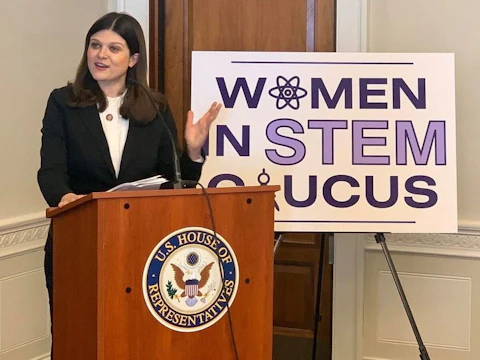Before she was a legislator, State Sen. Dayna Poklehanki spent 20 years as an English teacher. This year’s education budget, she says, is a historic point of pride.
EAST CHINA, Mich.—Schools all over the state have been forced to make do on shoestring budgets. In East China, home to a three-town school district along the border with Canada, aging infrastructure provided significant challenges for schools during the pandemic.
East China substitute teacher Parker Shea, who grew up in the district, has watched those decades of disinvestment unfold up close.
“[There are] loads of ceiling leaks, some classroom doors are so old they don’t have proper locking mechanisms to help in a lockdown situation,” Shea told The ‘Gander earlier this year. “The heating and cooling systems are a mess and costly.”
Shea’s perspective is shared by another teacher in the district, English teacher Kim Eberhard. Eberhard spoke to The ‘Gander about the difficulties of in-person education during 2020, and made the connection to education investment abundantly clear.
SEE ALSO: Keep Going Michigan: How to Work in Education Without Running for Office
“Education has been neglected for decades and now everyone will discover how bad it has been,” she told The ‘Gander. “Our buildings are old. The halls and classrooms are small. There is not a proper ventilation system appropriate for pandemic measures. The federal government would have to create new structures which would meet safety requirements along with technology for all kids who need it at home.”
East China School District told The ‘Gander it’s been working to address those issues within the district’s means, but the funding can be hard to come by.
Similar disinvestment woes plague schools statewide. But some help is finally here.
Michigan has put into place a landmark $17 billion bill to help out schools in need. Getting that bill passed was a point of pride for state Sen. Dayna Polehanki (D-Canton).
“[Schools] went through an exceptionally tough year, and I’m really proud that there’s going to be a historic amount of funding given to schools,” she told The ‘Gander just moments after Senate approval of the package. “I’m very interested in any law that will allow students and teachers to thrive.”
This funding is personal to Polehanki. Prior to being elected to the Senate, she spent 20 years as a high school English teacher, and following her election she became the highest-ranking Democrat on the Senate Education Committee.
RELATED: Free Preschool Plan Sets Stage for Michigan’s Modern Families
Polehanki characterized the funding as a much-needed jolt of support made possible by COVID relief money Michigan has collected over the past year, where the virus highlighted just how dire the situation in Michigan’s schools were. She excitedly listed to The ‘Gander what this kind of funding could mean for Michigan schools.
“It’s really going to let schools have what they need to give students the best education possible,” she said. “Schools are finally going to have some funding. They’re not going to have to scrimp and save. And they’re going to hopefully be able to pay teachers more, have all the books and computers and resources they need, maybe get great heating and cooling systems in school buildings—which are always outdated and, most of the time, broken.”
Schools Need More Than a One-Time Jolt
That said, Polehanki is concerned that when the funding for schools comes from an extraordinary source, it might be a blip in the greater trend of education disinvestment if legislators don’t commit to change.
Ultimately, she said, the money schools are seeing is a one-time benefit, but she’s hopeful that it may turn the tide on a long track record of disinvestment.
“I hope that this historic amount of funding is sustainable into the future,” she said. “We can’t just have a shot in the arm here or there. We’ve got to move toward what the School Finance Research Collaborative (SFRC) says is best—that’s a weighted funding formula that provides true equity to schools and gives schools what they need for where they’re at.”
UP NEXT: ‘It’s Just a Hard-to-Imagine World’: Rural Michiganders Open up About Living Without Broadband
In their most recent report on post-pandemic needs of schools, the Michigan-focused SFRC found that while short-term solutions are covering the gaps in school funding, the per-student funding schools need on average is over $10,000. SFRC calls this moment a “once-in-a-lifetime” opportunity for legislators to reinvest in education for generations of Michiganders to come.
Polehanki explained SFRC’s weighted funding approach as matching funding needs to the individual students. For instance, high schools cost more to operate than middle schools, and students with disabilities take more funding than those without to give the same quality of education. Combining that with the escalating costs of education in a post-pandemic world would allow state budgets to work smarter with the money it has, she argued.
But what passed this year is still something to be proud of, said Polehanki.
She highlighted closing a decades-old funding gap between the richest and poorest school districts and making preschool available to all 4-year-olds statewide. She also advocates for making kindergarten mandatory in Michigan, which it currently isn’t.
“That is huge,” she said. “I’m encouraged. This is one time I’m actually encouraged by a budget.”





